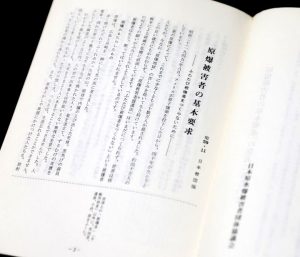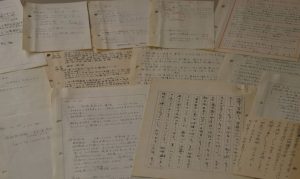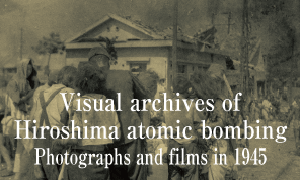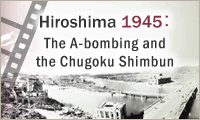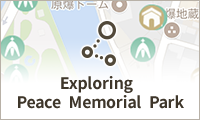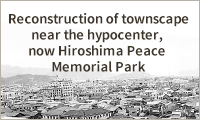Documenting Hiroshima 80 years after A-bombing: November 18, 1984, Nihon Hidankyo releases basic demands
May 9, 2025
Nihon Hidankyo collects survivors’ opinions from across Japan, rebuts national government
by Michio Shimotaka, Staff Writer
On November 18, 1984, the Japan Confederation of A- and H-Bomb Sufferers Organizations (Nihon Hidankyo) held a meeting in Tokyo of prefectural representatives, deciding on what became known as the “Basic demands from A-bomb survivors.” The basic demands document was developed after Nihon Hidanko solicited the opinions of the A-bomb survivors (hibakusha) broadly throughout Japan. With the subtitle “No more hibakusha,” the demand document urged the governments of Japan and all nuclear-armed nations to take action.
On behalf of the organization, Reiko Yamada, 50 at the time, who is now 91 and a resident of Tokyo, read aloud the document at a press conference held after the meeting. Looking back at the event, Ms. Yamada said, “The document accurately described the thoughts of A-bomb survivors. I believed at the time that it must be passed on to later generations.” She had experienced the atomic bombing in Hiroshima City’s present-day Nishi Ward and later became involved in the A-bomb survivors’ movement in Tokyo.
In the document, Nihon Hidankyo emphasized that “the atomic bombings continue to damage the bodies, lives, and mental health of the A-bomb survivors to the present time,” adding that “nuclear weapons are such an absolute evil that humanity cannot accept their existence.” It placed the abolition of nuclear weapons and the establishment of an atomic bomb survivors relief law based on compensation from the national government as the pillars of its activities.
The demands document sought a formal apology from the government of the United States addressed to the A-bomb survivors based on that nation’s acknowledgment that the atomic bombings had violated humanity and were a violation of international law. It also urged the United States to discard its nuclear weapons as evidence of its contrition. Meanwhile, the document called on all nations in possession of nuclear weapons to immediately enter into a treaty for a total ban on the weapons.
Atomic Bomb Survivors Relief Law “obligation” of Japan’s government
Moreover, the A-bomb survivor demands document argued that immediate enactment of the Atomic Bomb Survivors Relief Law to be an “obligation” of the Japanese government. As its responsibility for waging the war, it demanded that the government provide pensions to A-bomb survivors to compensate for physical and psychological suffering not limited to A-bomb radiation’s effects, as well as compensation to the bereaved families of those killed in the bombings. It defined national compensation as “a pledge that the government will not ask its people ‘endure’ devastation from nuclear war.”
The impetus for development of the demands document was submission to the national government of a report issued by the Conference for Fundamental Problems of Measures for the Victims of the Atomic Bombs (Kihon-kon), held in 1980. Emphasizing “endurance,” the report stated that all citizens should bear the burdens of war damages equally, with the government agreeing to provide aid to those suffering from radiation effects but rejecting the provision of compensation for the victims who died in the bombings. Kazuto Yoshida, 93, a resident of Tokyo and a survivor of the Nagasaki atomic bombing said, “Through a series of debates at the national level based on our anger against the Kihon-kon Committee, momentum built for a proper rebuttal.” At that time, Mr. Yoshida was serving as Nihon Hidankyo’s assistant secretary-general.
Starting in 1981, Nihon Hidankyo held throughout Japan what were known as “Peoples Tribunals,” mock trials in which the national government’s responsibilities for the war were examined. The organization also conducted a survey to collect the demands of A-bomb survivors. A summary report of the survey (based on responses from 3,690 survivors), released in the summer of 1984, revealed that three-quarters of the respondents had described in the description field their wishes that “hibakusha must never again be created.”
When a draft of the basic demands document was being put together in October, 67 opinions had been raised by member Nihon Hidankyo associations throughout Japan. Just prior to its announcement, the draft had been revised more than 20 times. Yoshie Kurihara, 78, a resident of Tokyo who was then working in the secretariat of the Nihon Hidankyo organization, said, “I sensed great passion from the survivors.” Mr. Yoshida added proudly, “The demands document was formulated by concentrating the full wisdom and power of the A-bomb survivors.” It also incorporated a sentence about the Atomic Bomb Survivors Relief Law, indicating, “Such a law would open the way for compensation of war damages inflicted on the general public.”
New support also provided
Opposition to the report issued by the Kihon-kon Committee also led to a new movement for supporters of the A-bomb survivors. In 1981, in Hiroshima, medical staff and attorneys founded the Association of Counselors for Hibakusha.
Setsumi Wakabayashi, 79, a resident of Shobara City and a former social worker at the Hiroshima Atomic-bomb Survivors Hospital, was one of the participants in the association. Ms. Wakabayashi met survivors with keloids from the atomic bombing who had become isolated from society, as well as A-bomb orphans who had lost their parents, making her realize that relief measures offered by the national government to the A-bomb survivors were insufficient. “How did their lives change before and after August 6 and 9th, 1945? After comparing the various measures with the effects on their bodies, mental states, and lifestyles, I thought that it was necessary to set about clarifying the entire picture.” Along with colleagues in the association, she began to provide interdisciplinary lifestyle guidance.
(Originally published on May 9, 2025)

